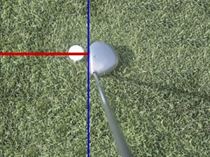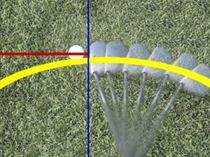Every golfer wants a great golf swing. You’ve taken lessons, watched the videos, practiced on the driving range, and still you slice, you hook, you hit into ponds and woods — everywhere but the fairway. And if you don’t hit the fairway with your drive, you know you’re heading for a bogey for sure. (I’m talking to myself here as well… lately my good golf swing has gone the way of some extinct species.)
So what’s going on? It’s time to break the golf swing down into simple steps, and in the process, discover what you (and I) might be doing to cause that slice.
Like any structure, the golf swing starts with a good foundation. The entire process of swinging the golf club is one of “cause and effect.” Like dominoes, each movement is part of the whole, and it is critical to see each component not as a separate entity but as part of an entire process. Every small adjustment, the first movement that begins the sequence, is as critical to the whole as the last.
The first step is your grip. You must hold the club firmly but not too firmly. This video with PGA golfer, Sarah Bidney, illustrates the correct way to grip the golf club.
Recently I had the grip on my driver replaced. I had been holding the club so tightly, there was a dent in the rubber. So that’s a first clue why my golf swing has “gone away.”
Second step is your posture. You want to be well balanced, feet about shoulder distance apart. And for most shots the position of the ball in relation to your outside foot will be a just a bit inside your heel. Your back should be neither rounded, nor swayed, but relatively straight, with your backside up slightly… but don’t exaggerate this. Some instructors tell you to “pretend you are sitting on a bar stool.” Too much “bar stool” and you will be off balance as you swing.
In the following video, GolfGurls fitness trainer, Kathy Ekdahl offers a Golf Posture Assessment.
Third step in your golf swing is alignment. How do you set up to your target? I’ve seen some players line up in front of their ball, look over their shoulder at the target and then line the club face parallel to their shoulder line. If you do that, your ball will always miss its mark. Think about it. Parallel lines that extend off into the distance never meet. So if you line up your target with your shoulder, your clubface will always be a couple yards off the actual target line.
Your golf club should line up square to the target. Before each shot stand behind your ball facing the target. Find a small piece of grass or leaf that is just a couple of feet in front of the ball and between you and the target. Align the club face square to that mark, then take your stance. In the graphic to the right, the red line indicates the line to the target. The blue line over the face of the club is square or perpendicular to the target. Your shoulders should be perpendicular to your clubface and parallel to the target line. Your shoulders should not be pointing at the target.
 Next is swing path. As you swing, the clubface will naturally open on the backswing and close on the follow-thru. If you are swinging on the correct swing path, the clubface should be square to the target as it hits the ball. This will produce a nice straight shot. The graphic to the right gives you some idea of how this looks.
Next is swing path. As you swing, the clubface will naturally open on the backswing and close on the follow-thru. If you are swinging on the correct swing path, the clubface should be square to the target as it hits the ball. This will produce a nice straight shot. The graphic to the right gives you some idea of how this looks.
If you find yourself hitting a lot of slices (ball goes to the right) or hooks (ball goes to the left) you are not squaring the face of the club to the ball at impact. If the clubface is open on impact, you will likely hit a slice. If the clubface is closed on impact, you will most likely hit a hook shot. (You’ll get a straight shot provided you stay steady in your stance, don’t lift your head, sway your hips, or do one of a hundred little things that can throw the whole thing off. Trust me, I’ve done them all.)
(Note: there are times when you might actually want to deliberately create a slice to the right (a tree might be in the way) – where the shot starts left, but then gently curves to the right. This is called a “fade” shot. The opposite is also possible, when you deliberately create a hook, i.e. ball starts right and then curves gently to the left. This is known as a “draw.” The way to achieve these trick shots is to open or close the clubface upon impact.) I like to think that all my slices and hooks are deliberate fades and draws. Only problem is that they don’t stay on the fairway. It seems I’ve been able to practice a lot of trouble shots lately.
The last step in perfecting your golf swing: Take A Lesson. We all need objective advice. No matter how bad or good your swing is, consistency is the key to success in golf. If there is one guarantee in this sport, it is that every round will be different and every swing an opportunity for success or failure. Taking a lesson from a pro is a great way to fine tune your swing, discover anything that needs tweaking (or in my case, an overhaul of technique) and learn to play more consistent good golf.







I’d like to find out more? I’d want to find out some additional information.
Hi Liliana, what specifically can we help you with? Check out some of our previous blog posts.
Hi there very nice web site!! Guy .. Beautiful ..
Wonderful .. I will bookmark your site and take the feeds also?
I’m glad to seek out a lot of useful info here
within the publish, we’d like work out more techniques in this
regard, thanks for sharing. . . . . .
I am guilty of not turning my shoulders enough… end up swinging more arms… got to remember to turn away from the target before the downswing… there’s a lot to remember…or at least to teach your muscles to remember!
Slicing can be a pain in the @55. What many people don’t realise about it, is that they are probably doing something like not shifting their weight properly or swinging the club. I know a common thing beginners do is swing their shoulders but not their arms properly.
Thanks John. Glad the article reinforced some of what you already know. These ideas work for me!
Really nice article!
Alignment issues can creep up on you gradually, so it’s important to spend a bit of time on your alignment drills at regular intervals.
I used to constantly fade (or slice!!) the ball with my irons, but after working on correcting both my swing path and my alignment, my natural shot is now a slight draw – with the added bonus of an increase in distance.
All the best,
John.